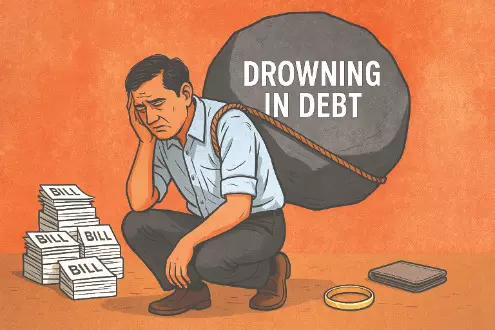Vicious Debt Trap
India’s once-proud middle class, the engine of its economic miracle, is financially drowning as savings evaporate and loans rocket. Now is the time to stem this rot

“This is an anxiety driven world.
It is anxiety about the aftermath
of the global financial meltdown.
It is anxiety about inequality and
about computers replacing jobs.”
— Robert J Shiller
India’s middle-class, once the lodestar of the country’s economic rise, stands at a deathly precipice. For three long decades, this is the class that has paid its taxes, driven consumption, invested in education, saved for and bought homes, and kept alive the faith in India’s ‘Growth Story’. Today, people in this segment can barely be recognized—broke, bruised and increasingly battered as they are. EMIs have replaced ambition, collection calls have replaced any last vestiges of hope and the promise of upward mobility has withered into a quiet, unspoken panic.
This slide is not an abstraction, but written in hard numbers. Household savings are at a 50-year low. Debt is soaring. Defaults are climbing so fast that even top bankers are getting nervous. Monetary institutions have issued multiple warnings too, flagging ‘elevated delinquency risks’ in unsecured bank lending and calling for ‘enhanced vigilance’ by targeted institutions to contain the contagion. The saving grace–the Government has taken notice and has stepped in with a ‘revitalization package’.
The numbers are worrisome. The share of unsecured loans in total bank credit has grown to 25.5 per cent. In its ‘Trends and Progress of Banking in India’ report, the Reserve Bank of India stated: “Some entities have high ceilings that need monitoring. Prudence is critical to maintain systemic stability.” RBI’s language may be clipped, but the meaning is stark… India’s credit edifice is showing cracks.
Drowning in Debt
The middle-class debt trap is visible from every angle. Personal loan NPAs have shot up by 51 per cent, nearing Rs 12,000 crore. Towards the end of last year itself, credit card defaults stood at Rs 6,742 crore, up 28 per cent in a year and six times 2020 levels. The number for this year is expected to be higher, and that is what has triggered a new and silent scream. Gold loans… But even here, defaults have risen from Rs 1,404 crore in 2023 to Rs 2,040 crore, a staggering jump of 51 per cent. For millions of Indian households, pledging family gold is not a mere financial act, it is surrendering their last reserve of dignity. As a banker said: “When the gold starts going, all hope goes with it.”
The silver lining in this financial cloud is that NPAs in education loans have fallen from 5.8 per cent to 2.7 per cent, though they are the highest in the retail segment, followed by consumer durables and credit card loans. The financial quicksand is spreading. This is seeing even private credit—a grey, lightly regulated space—come under scrutiny. The RBI has warned that interlinkages between credit firms, banks and NBFCs are “leading to systemic concerns”. The phrasing may be technocratic, but the drama is real. Once-proud families are borrowing to survive, not to build futures.
The pressure is spawning a new, unsettling ecosystem. Banks, starved of manpower and desperate to retrieve their money, have hired recovery agents—crass-speaking men and women who earn modest salaries but hefty commissions when they manage to get back money from defaulters—by hounding and threatening them. A new breed of ‘credit resolution’ companies has also been born.
Threats: A Booming Business
Ritesh Sachdeva, who runs one such ‘collection firm’, says: “Hundreds of our clients earn Rs 40,000-55,000 a month, but owe Rs 30-35 lakh each in five to six different loans. How can they pay even the interest?” His statement may be alarming, but his business is booming, showing 15-per cent annual growth. The middle-class’ ruin has become someone’s gold rush, yes, but it didn’t happen overnight.
The unravelling began in 2017-18, when private sector salaries stagnated and appointments slowed down. Things hit the fan right and proper when what everyone assumed was a pause turned into a high-decibel blast. By the time COVID-19 struck in 2020, the middle-class was wobbling. Resultantly, the pandemic didn’t just hit Indians; it gutted them. Families took personal loans to keep kitchens running. Then came loan rollovers; new loans to service old ones. After that failed, people maxed out credit cards. When even that collapsed, people pawned gold. This was not just the crisis measure of a few, but something of a national pattern in India’s glittering metropolises.
The middle-class, which powers consumption—cars, two-wheelers, homes and insurance—has been the most fragile trough in the debt tidal wave. Consumer confidence has eroded. Aspirational spending has shrunk, with the middle-class rhythm of cautious optimism getting replaced by a doleful hum of anxiety. This has only helped those holding the new, perverse jobs—recovery agents, now as common as delivery riders. For them, chasing defaulters has become a full-time job. “The financial stress that created the rot is now creating jobs,” an analyst said. “It is capitalism eating its tail.”
Death of Savings Cushions
India’s middle class was once cushioned by a legendary ‘Savings Culture’. The matriarch with her rice tin stash wasn’t just a cultural trope, she was a parallel to the esoteric bank. But that cushion has been shredded. Inflation has devoured disposable income. Job quality has eroded. Safety nets have been stretched. India’s per capita income is now US $2,878 (about Rs 2.56 lakh), ranking it 136th globally. It is behind Bhutan ($4,302), Sri Lanka ($4,325) and Thailand ($7,767), says the International Monetary Fund (IMF). While numbers for Pakistan are fuzzy, Bangladesh saves India the blushes with US$2,689.
Household debt figures are also alarming, rising from 35 per cent of the GDP in March 2020 to 43 per cent by end-2024. Inflation has pushed the cost of living to record highs, while salaries have remained stagnant. Surveys show 23 per cent of India’s middle-class have seen incomes fall over the past year. Gold loans have rocketed, up 71 per cent in FY 2024-25, compared to 17 per cent in the previous year. These aren’t people juggling liquidity balls, these are people fighting to keep their head above water. A class that lived for foreign vacations, private schooling, home upgrades and early retirement is now living in dread of a recovery call.
Is There a Way Out?
Thankfully, yes, and it involves those with intrinsic knowledge of ground reality and how to make things better. The Government and the RBI are pulling out rabbits to stabilize the banking system and clean up the credit mess, secure in their confidence that India’s long-term growth story remains intact, and that a per capita income of Rs 15 lakh will be achieved by 2047. That confidence bodes well for tomorrow, but for crores of Indians, the future means little when the present is falling apart; For these people, the sanguinity is jarring. For the nation, this is more than a credit problem. It is a class crisis.
To rectify faults of such magnitude, policy actions are needed. They have to be direct, muscular and sustained—targeted income support, structured debt relief and loan restructuring programmes, apart from interest subvention for unsecured borrowings. These will offer some relief. South Korea and Japan have used structured wage support and credit backstop schemes during downturns to protect the middle tier. Tax incentives for households, low-interest refinancing windows for gold loans and stricter oversight of private credit networks are other possibilities to fight the debt stranglehold.
The middle-class is the spine of the economy. If that spine bends too far, the structure will creak. India is facing a silent financial crisis, one that has not grabbed headlines yet, but one that is oh so real. It shows up in unpaid credit card bills, empty savings accounts and gold bangles lying in a lender’s vault. We need to move to bolster the class that built modern India, before the weight of loans drags these people down. In the longer run, we can rebuild growth. We also build confidence too. But hope, if the middle-class loses it, will be very hard to recover.
He can be reached on [email protected]. Views expressed are personal. The writer is a veteran journalist and communications specialist



